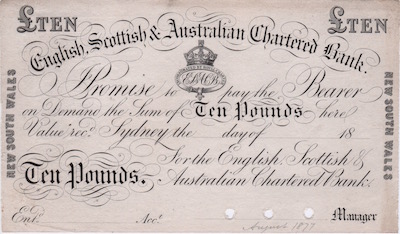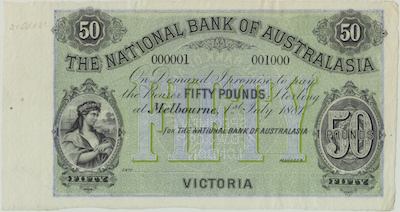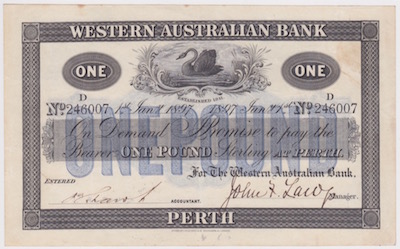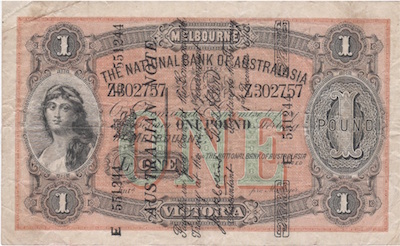Australia's Pre-Federation Banknotes - A Rich and Complex Series

Australia's pre-Federation banknotes are a rich and complex series that captures the history of Australia’s growing economy throughout the 19th century.
As these privately-issued notes are so starkly different to the single series of currency notes we use across the country today, it is an area that can be foreboding for the novice collector.
A large number of banks issued notes across many cities; states and decades - each one of those banks issued several different series of notes, often with markedly different designs and often in different denominations.
As the cost of a pre-Federation note can run into the hundreds; thousands and even tens of thousands of dollars, rather than risk making a decision that might cost them a significant sum, many collectors choose to steer clear of this series completely.
This is a real shame, as Australia’s banking system during the 1800’s has been described by one prominent economist as "one of the most interesting historical experiences of free banking. Australian banking was relatively free for almost a century…"1
The banknotes issued by Australia’s private banks during this period are tangible mementos of "how well the theory of free banking has worked in practice.” 2
This is a series that is unique in world numismatics, they are a physical record we can all be proud of.
The first step in understanding one of these notes is to learn how each it is classified into one of four forms - proof, specimen, issued and superscribed. Each of these different classes has their own appeal to collectors.
Printer's Proof Note:
Printer’s proof notes were generally used by printing and bank staff in the early stages of the printing process when signing off on design elements and designs.
Proofs are usually (but not always) printed in black ink, and are often (but not always) printed on firm card. Printer’s proof notes can be printed either just on one side or on both sides.
Minor elements of the design of a printer’s proof note may differ from those seen on the issued version of the note.
Printer’s proof notes often have notations in either pencil or ink by bank or printer staff in the margins.
Although some printer’s proof notes have the term “Specimen” stamped or punched into them, this alone does not designate them as specimen notes.
Some pre-Federation notes are only known in the form of printer’s proofs.
Printer’s proofs are reasonably distinct from the issued notes they were intended to represent, so although many of them are extremely rare, they are the most affordable type of pre-Federation notes available to collectors.
Specimen Note:
Specimen notes were intended to stand as evidence of the final version of a note to printing and bank staff before it entered circulation.
A specimen note has passed through each phase of the printing process (intaglio and simultan), and generally (but not always) has had serial numbers added to it.
Specimen notes are printed on paper (not card), and often (but not always) have the term “Specimen" either stamped onto or punched into them.
A note with the term “Specimen” stamped onto or punched into it is not necessarily a specimen note - it must have the above characteristics if it is to be correctly classed as a specimen note.
A specimen note will not have been signed by authorized bank staff.
As nearly all pre-Federation notes are rare and often expensive in issued form, specimen notes are often used to represent a particular bank, denomination or series in a collection.
A specimen note may also be used to represent a note as it would have been seen in circulation when all of the issued notes available are heavily circulated - faded; dirty; torn or perhaps even missing sections.
Some pre-Federation notes are only known in specimen form.
Specimen notes are the most attractive of all pre-Federation notes.
Issued Note: 
An issued pre-Federation note that has been fully printed, has had serial numbers added to it, and has been signed into circulation by the bank’s authorized representatives.
Very few issued notes were printed in black ink only; very few issued notes were printed on one side only.
An issued note will not have the term “specimen” stamped onto or punched into it.
As notes issued into circulation during the pre-Federation period had a significant purchasing power, most circulated for an extended period of time.
Very few were either saved for posterity or lost - nearly all were spent or redeemed at the bank that issued them, and so most are found in heavily circulated condition.
Issued notes in superior quality are the most highly-prized of all pre-Federation notes. They are valued for their rarity; history and purchasing power.
Superscribed Note:
A superscribed note is an un-issued pre-Federation note that was printed for a private Australian bank, and has been officially overprinted either by the Queensland Colonial Government or the Australian Commonwealth Government.
As there is only one superscribed note from the Queensland Colonial Government in private hands, the term “superscribed note” is invariably used to describe those notes over-printed by the Australian Commonwealth Government.
The Australian Commonwealth superscribed notes feature the term "AUSTRALIAN NOTE” above authorizing text across the front, with serial numbers above and below, all in black ink.
These superscribed notes were intended only as a temporary measure until the Commonwealth’s own series of notes was designed, printed and issued into circulation.
Once their purpose had been served, superscribed notes were actively recalled and destroyed by the Commonwealth Treasury, so very few remain available to collectors today.
As the first notes printed for the Australian Commonwealth Government, superscribed notes are highly prized for their history, rarity and purchasing power.
Superscribed notes are not known in printer’s proof or specimen form in private hands.
Summary
Determining whether a particular note is a printer’s proof; a specimen; an issued or a superscribed note is the first step in determining how it fits into the schema of Australia’s pre-Federation note series.
Subsequent identification tasks such as determining the series that a note is part of is made much easier once the note has been correctly classified into it’s form.
1. Dowd; Kevin, "Free Banking In Australia", Taylor & Francis, London, 1992.
2. Dowd; Kevin, "Free Banking In Australia", Taylor & Francis, London, 1992.
